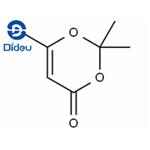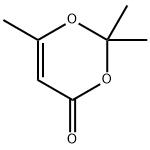It is usually used as intermediate or raw material in the chemistry synthesis. For example, 2,2,6-Trimethyl-4H-1,3-dioxin-4-one can act as the starting material to produce N-alkenyl acetoacetamides through reaction with imines.1 This substance can also be involved in the preparation of acetoacetamide derivatives, which result in the formation of the pyrrole amides via oxime of the acetoacetamides.2 Moreover, this chemical may be introduced to promote the acetoacetylation of O-(hydroxypropyl)cellulose for generating O-(acetoxypropyl)cellulose.3 In addition, this chemical may be used to yield β-keto esters and β-ketoamides through the reaction with secondary or tertiary alcohols (including chiral ones) or primary or secondary amines.4
- Dannibale, A.; Pesce, A.; Resta, S.; Trogolo, C., Reaction of 2,2,6-trimethyl-4H-1,3-dioxin-4-one with imines: An easy route to enamides. Tetrahedron Lett. 1996, 37, 7429-7432.
- Huggins, M.; Barber, P.; Florian, D.; Howton, W., Short, Efficient Syntheses of Pyrrole -Amides. Synth. Commun. 2008, 38, 4226-4239.
- Pawlowski, W. P.; Gilbert, R. D.; Fornes, R. E.; Purrington, S. T., ACETOACETYLATION OF O-(HYDROXYPROPYL)CELLULOSE BY 2,2,6-TRIMETHYL-4H-1,3-DIOXIN-4-ONE. Carbohydr. Res. 1986, 156, 232-235.
- Sridharan, V.; Ruiz, M.; Menendez, J. C., Mild and High-Yielding Synthesis of beta-Keto Esters and beta-Ketoamides. Synthesis 2010, 1053-1057.
Diketene-Acetone Adduct can be used in place of diketene in many reactions. As a transportable form of diketene, it is especially important in those countries, where the transportation of diketene is not allowed or at least not desired.
2,2,6-Trimethyl-1,3-dioxin-4-one is used in the synthesis of dihydropyrimininones as picomolar sodium iodide symporter inhibitors. It is also used in the synthesis of resorcinol amide Hsp90 Inhibitor AT13387. It is used in the synthesis of acetylketene by flash pyrolysis.
2,2,6-Trimethyl-4H-1,3-dioxin-4-one generates unstable acetylketene together with acetone when heated above 120 ℃. Subsequent condensation with isocyanates, arylcyanates, or substituted cyanamides gives access to a wide range of 1,3-oxazine derivatives. Furthermore, diketene – acetone adduct can also be used for the preparation of a variety of compounds that are not accessible from diketene.
Diketene – acetone adduct (2,2,6-Trimethyl-4H-1,3-dioxin-4-one) can be regarded as a stabilized form of diketene. It can be safely transported and may conveniently be used instead of diketene in many reactions. For example, it reacts with alcohols and amines to yield acetoacetates and acetoacetamides, respectively. Diketene – acetone adduct generates unstable acetylketene together with acetone when heated above 120 ?C. Subsequent condensation with isocyanates, arylcyanates, or substituted cyanamides gives access to a wide range of 1,3-oxazine derivatives. Furthermore, diketene – acetone adduct can also be used for the preparation of a variety of compounds that are not accessible from diketene.



